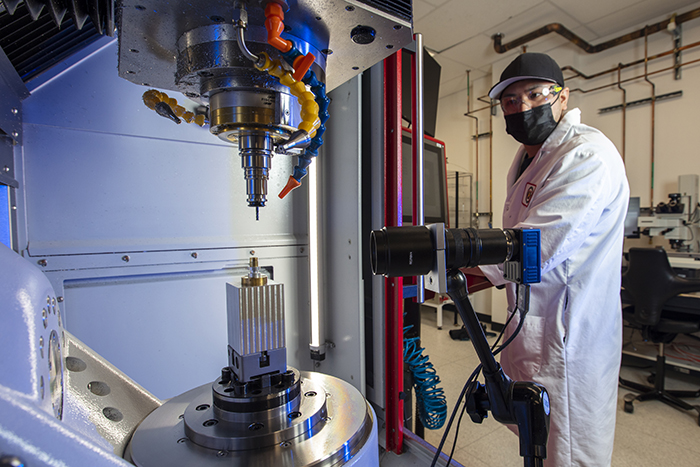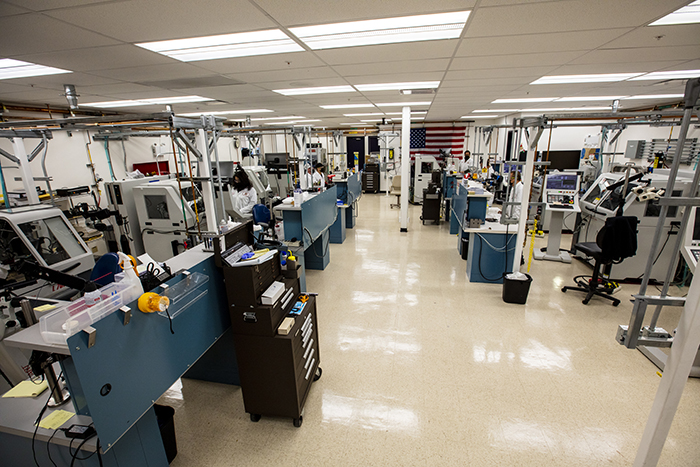Target Fabrication Precision Applied to Machining Operations Move
March 31, 2022
 Precision machinist Alan Ma operates one of the new machines installed in Target Fabrication’s new home for machining operations. This Kern Micro Vario 5-axis milling center with 100-tool capacity and acoustic sensors can complete parts in a single operation, handle larger parts to 1 micron accuracy, and conduct measurements in situ. Photos by Jason Laurea
Precision machinist Alan Ma operates one of the new machines installed in Target Fabrication’s new home for machining operations. This Kern Micro Vario 5-axis milling center with 100-tool capacity and acoustic sensors can complete parts in a single operation, handle larger parts to 1 micron accuracy, and conduct measurements in situ. Photos by Jason Laurea At the end of every laser shot at the National Ignition Facility (NIF) is a target. These tiny engineering marvels are precisely crafted to deliver insight into the workings of extreme high energy density (HED) science.
Without targets, there are no shots, so when machining operations for Target Fabrication were upgraded and consolidated with the rest of the program, it had to be done without missing a minute of the continuous work of designing and delivering targets to the world’s largest laser.
“Precision micro machining is one of the core capabilities for Target Fabrication at LLNL, used for various experiments at NNSA’s major high energy density science facilities—the University of Rochester’s Omega Laser, Sandia National Laboratories’ Z machine, and of course the National Ignition Facility,” said Abbas Nikroo, Target Fabrication program manager.
Operators are highly trained as this type of machining is quite different from traditional machining, both turning and milling operations, and requires specialized programming. Many targets used for such experiments require nanometer precision over millimeter sizes. This capability is also used to produce plutonium targets, using techniques developed on other materials for this specialty material.
“Given the interconnectivity of this operation and the other work in Target Fabrication, integration of this precision micro machining, including co-location, is critically important for efficient and high-quality target fabrication,” Nikroo said.
A carefully choreographed move
The relocation began back in 2019 at a small scale. The rest of the relocation, delayed for various reasons until August 2021, included facility renovations and careful staging. As soon as the first three pieces of equipment were installed and qualified in the new location, three precision machinists followed to continue their work on the new equipment. The move continued over the next few months in similar stages. A coordinated effort between machining group personnel, project managers, LLNL riggers, the NIF Facility and Infrastructure Systems (FiNS) team, Materials Engineering Division’s machine tool services, the Environment, Safety & Health (ES&H) program, the NIF logistics team, and many others kept both the move and continuing work on track.
“It’s quite an upgrade,” said Matthew Arend, the machining shop supervisor. “Some of our old equipment was running on DOS-based computers. We now have diamond turning capability and can machine parts at an ultra-precise level, at the nanometer range. Not many shops in industry can compete with this.”
 Target Fabrication has completed this consolidated new home for machining operations.
Target Fabrication has completed this consolidated new home for machining operations.
The new capabilities enable NIF to continue pushing the boundaries of science. An upgraded new white light interferometer can measure surface roughness to a nanometer range. The LLNL machinists build their own fixtures to enable simultaneous measurements of the front and back of a target, allowing thickness measurements to less than 100 nanometers over hundreds of micrometers. This capability is essential to equation of state targets which probe the behavior of materials of interest at extreme conditions that can only be produced by the NIF laser.
In addition to increased capabilities, the new equipment and efficiencies gained from consolidating with Target Fabrication, the machining shop is hiring machinists into its apprenticeship program. That’s where Arend started in 2007, fresh out of a machining program at Napa Valley College. In less than 15 years, he advanced from an apprentice to a journeyman to the shop supervisor.
“Machining precision targets at Lawrence Livermore is a job that challenges and energizes me every day,” he said. “The machinists here are operators, technicians, and artisans. We build all of our own tooling to meet the exact needs of NIF Target Fabrication. Some of these machines were designed for optics, but we are using them for small precision parts. We customize everything and continue to innovate to push our capabilities.”
That drive for excellence is necessary to keep pace with experiments at the NIF, where a large, diverse team continues to push the laser’s energy and power to higher levels. In August 2021, a record-setting inertial confinement fusion experiment produced 1.35 megajoules of fusion energy.
“The relocation of equipment also opens the door for further expansion,” Nikroo said. “We are planning to add new micro electro-discharge machining and combined laser/machining tools to nearby labs in the building to further enhance capabilities. Such a collection of trained personnel and capabilities is virtually unrivaled in the national target fabrication complex and continues to produce unique components for Weapons and Complex Integration (WCI) and NIF programs.”
—Patricia Koning
Follow us on Twitter: @lasers_llnl



